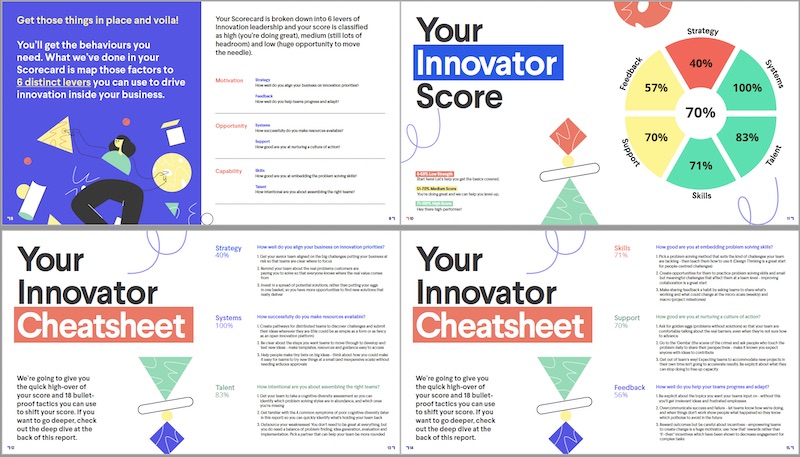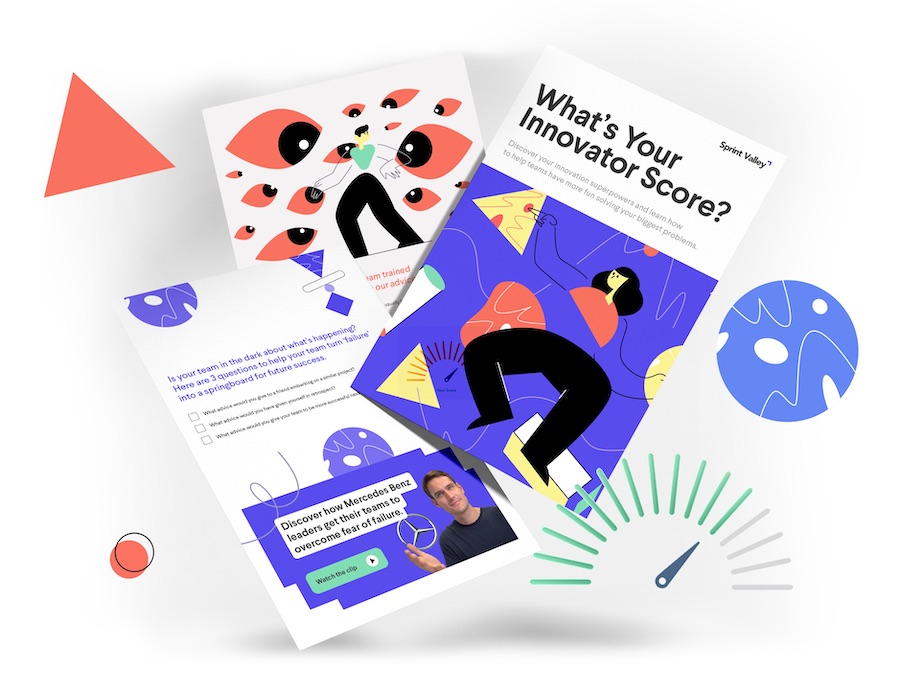You can reflect on questions and take an innovation test below to self-assess your own leadership for innovation with the Innovator Scorecard. The assessment is about 20 questions in length and takes about 3 minutes to complete. These dimensions are strategy, systems, talent, skills, support, and feedback. 
Below are the innovation behaviors you can improve on to help your organization. The assessment will let you know how you rate and provide suggestions and videos to help with these actions or behaviors. This innovation test is a helpful self-assessment resource and first step for those who want to foster a culture of innovation in their company or lead innovation teams.
You can try rating yourself on a scale of 1-10 for each question and tabulating your results in a spreadsheet. Note which areas were your highest scoring and which were lowest.
A. Strategy
How well do you align your business on innovation priorities?
1. Get your senior team aligned on the big challenges putting your business at risk so that teams are clear where to focus
2. Remind your team about the real problems customers are paying you to solve so that everyone knows where the real value comes
from
3. Invest in a spread of potential solutions, rather than putting your eggs in one basket, so you have more opportunities to find new solutions that really deliver
B. Systems
How successfully do you make resources available?
1. Create pathways for distributed teams to discover challenges and submit their ideas wherever they are (this could be as simple as a form or as fancy as an open innovation platform)
2. Be clear about the steps you want teams to move through to develop and test new ideas – make templates, resources and guidance easy to access
3. Help people make tiny bets on big ideas – think about how you could make it easy for teams to try new things at a small (and inexpensive scale) without needing arduous approvals
C. Talent
How intentional are you about assembling the right teams?
1. Get your team to take a cognitive diversity assessment so you can identify which problem solving styles are in abundance, and which ones you’re missing
2. Get familiar with the 4 common symptoms of poor cognitive diversity (later in this report) so you can quickly identify what’s holding your team back
3. Outsource your weaknesses! You don’t need to be great at everything, but you do need a balance of problem finding, idea generation, evaluation and implementation. Pick a partner that can help your team be more rounded
D. Skills
How good are you at embedding problem solving skills?
1. Pick a problem solving method that suits the kind of challenges your team are tackling – then teach them how to use it (Design Thinking is a great start for people-centered challenges)
2. Create opportunities for them to practice problem solving skills and small but meaningful challenges that affect them at a team level – improving collaboration is a great start
3. Make sharing feedback a habit by asking teams to share what’s working and what could change at the micro-scale (weekly) and macro (project milestones)
E. Support
How good are you at nurturing a culture of action?
1. Ask for golden eggs (problems without solutions) so that your team are comfortable talking about the real barriers, even when they’re not sure how to advance
2. Go to the ‘Gemba’ (the scene of the crime) and ask people who touch the problem daily to share their perspectives – make it known you expect anyone with ideas to contribute
3. Get out of team’s way! Expecting teams to accommodate new projects in their own time isn’t going to accelerate results. Be explicit about what they can stop doing to free up capacity
F. Feedback
How well do you help your teams progress and adapt?
1. Be explicit about the topics you want your teams input on – without this you’ll get irrelevant ideas and frustrated employees
2. Overcommunicate success and failure – let teams know how we’re doing, and when things don’t work show people what happened so they know which potholes to avoid in the future
3. Reward outcomes but be careful about incentives – empowering teams to create change is a huge motivator, use ‘now that’ rewards rather than ‘if > then” incentives which have been shown to decrease engagement for complex tasks
Innovation Test – Innovator Scorecard Assessment
App access to the innovator scorecard to see how you rate on the above innovation leadership behaviors is currently limited. Instead, you can simply follow along and rate yourself on the above questions as a reflective assessment activity. It can be good for self-awareness to see where you might rate the lowest and if there are any actions you can take that you weren’t aware of. This can be a lever to pull to accelerate innovation in yourself, your team, or your organization. Innovation tests and leadership assessments can help.
This innovation test is currently not available to take on an application that provides a report or aggregate team results. This was recently put on hold. The assessment app did include a very visual 40 page pdf with your results in addition to tips for changing innovation behavior across eight dimensions. We hope it will be up again soon.
Reach out to us at [email protected] for help with fostering a culture of innovation and more innovative teams through innovation assessments and other approaches.
